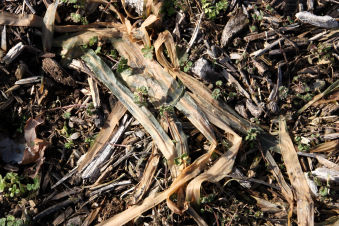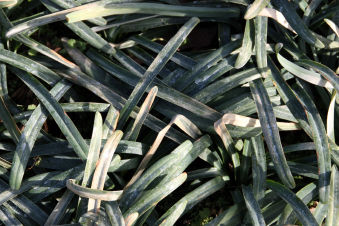January 20, 2010
A Practical Evaluation Of FreezePruf™
Sometime in the summer of 2009, I was made aware of a new product coming
to market, offered under the label, "FreezePruf™", which was touted to
be able to protect, by a difference of over 9°F, plants susceptible to
winter damage. As an example, by definition, if I was growing a plant
that would receive cell damage starting at 32°F, the use of this product
would protect the plant from the same damage down to under 23°F. Well!
Now, I thought to myself, "Wouldn't it be great if this product really
works and could protect some of my winter foliage Lycoris from significant
winter injury?" I decided to order a gallon of this product, enough to
make 4 gallons of solution, and test it on a number of my small Lycoris
plots this winter. Little did I know our region of the country would be
the recipient of some of the coldest temperatures we have seen in 15 years.
But, that's getting ahead of the story.
On November 15th, 2009, after having experienced a few frosts and freezes down to as low as 30°F with minimal damage to the most tender members of the study, FreezePruf™ was applied according to directions liberally across all upper facing surfaces of the foliage, which was fully established by this time. Directions require application to all surfaces, but lower surfaces were difficult to reach, making that aspect of the application impractical. Therefore, any reported results should take this into consideration.
FreezePruf™ directions recommend a six week interval between spray applications during the period in which damaging cold temperatures are anticipated. Additionally, although allowing for application at anytime above 32°F, they recommend spraying in >50°F temperatures with 12 hours of expected temperatures above the next freezing period. The initial application occurred within the parameters of the recommended guidelines. So, next application would have been scheduled for sometime around January 1, 2010.
After application, the remainder of November saw our lowest temperature at 31°F, foliage still receiving no significant threat. In the month of December, only 9 nights registered just at or above freezing temperatures. All other nights were solid freezes with the lowest extreme being 9°F, typical for our area of the the country. The longest stretch of subfreezing temperatures lasted over 48 hours. The scheduled time for re-application would have been around January 1, 2010, but the time surrounding was either wet or subfreezing, so no new application could be made before the historic freezes that were to occur in the first week of January. January brought temperatures as low as 1°F with temperatures at or below 5°F on five nights and two stretches of at least 72 hours below freezing.
Following are generalized observations of the various plots with included images to give a visual representation of the condition of the various species and varieties of Lycoris tested. Photographs and evaluations were taken on January 18, 2010.
WORST CASE |
BEST CASE |

Lycoris aurea var. surgensOUCH! This most tender member of the Lycoris clan proved it needed far more than a spray protectant to survive. Foliage was completely burned back. This, too was in open ground in full sunlight. |

Lycoris xhoudysheliiThis open ground plot in full sun received minimal damage, one of the most impressive subjects in the trial, with foliage even more upright than other plots. Please note that the residue of the first treatment is still obviously present on the foliage. |
CONCLUSIONS
Realizing that this is only a practical, subjective study, I believe FreezePruf™ deserves further evaluation by myself as a nursery grower. Based upon the expected behavior of the Lycoris radiata group and L. xalbiflora, I have noted what appears to be significant protection from very drastic low temperatures, not normally recorded for this area of the country. Additionally, a proper application to the underside of the foliage was not feasible, nor was the scheduled second application possible before the lowest temperatures were observed. An additional application was applied to surviving plots on January 18th after the photographs were taken. This product will probably be applied again next year in the hopes of evaluating under more normal circumstances and with a properly timed second application.
BLOG | GALLERY | GROWING GUIDE | FORUM
BUY BULBS | AUCTION | TESTIMONIALS | CATALOG | CONTACT | HOME